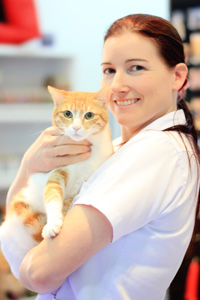July 19, 2020 by Dr. Sigrun Hackl
So imagine you have your life all set up, your favourite chair, your spotless bathroom, your special mattress bed, the high speed internet access and the full service at home, everything you dreamt off. And then they bring in this toddler. Or worse, an adolescent. He sleeps in your bed, poops in your toilet, eats from your plate, hogs up your internet and is just there all the time!
Would you get upset?

Probably yes. Especially since nobody asked you first.
So this is what happens if you suddenly bring a new kitten / cat into your household. The resident cat suddenly has to share and make space. Habits have to change, routines are disturbed, the peace and quiet of a lifetime (or so it feels), are suddenly gone. Cats like habits, they like to be in control, they like to know what is happening, they hate change.
Naturally, they will frequently find this new arrival disturbing, if not outright upsetting, and react accordingly. A shy character will withdraw and suffer in silence, a bold one will attack and defend what is rightfully hers.
So what to do. Is there a way to make them understand that there is room for both of them?
There is, but it may need some patience, careful planning, and adjustments.
First of all, give the resident cat as little reason as possible to feel threatened. Make sure that all resources are there in abundance, so that there is no need to fear competition. This will include:

Next, introduce the new addition gradually and step-wise, rather than just dumping them on each other. If the new cat needs to be quarantined for a time to be sure that he / she will not spread a disease, then choose a ‘low priority’ room such as a bathroom for the quarantine. If the new cat is healthy and fit and just needs time to adjust, set up a comfortable ‘retreat’ area for the newbie to feel welcome and safe in at all times.
While it is important for both cats to have this ‘safe retreat’ area, make sure that you do not accidentally create rival territories. How do you avoid this? Simply by frequently swapping the cats over and thus allowing both of them to inhabit the same areas, especially if the two characters are more hesitant about accepting each other and the introduction process takes longer.
How long should this take?
This highly depends on the cats. Some outgoing and social characters can be allowed out within hours. Others will take a few weeks in separate living quarters before they actually come to terms with the situation. It takes as long as the most timid cat needs to be OK with it. And all we need them to be is ‘OK’ with each other. They may not become best friends, but as long as they don’t mind the other one living there, as long as they see no threat to their own position, it’s fine.
Is there a way to speed up the process?
Yes, there is. In cats, it’s all about scent. Their world consists of smells. Whatever hits their nose will make them happy, wary, comfortable or defensive. They signal to one another who lives here, and what rules apply. Unfortunately for us, we are totally unaware of that entire communication. But we can still influence it in subtle ways if we understand some basics.
If a cat feels absolutely at home and safe in one area, she will usually rub her chin along all sides and surfaces, thus saying ‘this is home and I am safe’ in kitty cat world. There are glands under the chin that both release an individual scent marking, as well as a ‘happy’ pheromone. We can take advantage of this habit by creating little ‘scent tags’ with that marking, and leaving little messages around the house ourselves.
How do we do this? Very simple. Get your little tiger in a happy relaxed and cuddly mode (ideally happily purring), and as you snuggle and cuddle, grab some cotton pads (ie cosmetic pads or pieces of cloth) and gently rub them under her (his) chin to catch as much of those scents and pheromones as possible. Make as many little tags as you can and keep them in a sealed container, marked with the cats name. Do this for all cats in the house, new and old.
Now, whenever you see one cat chin rubbing in an area in the house, you grab the container with the other cats tags and attach one of the tags in the same spot. This leaves a ‘me too, I live here and I am happy’ message on that spot and creates an invisible presence of all cats in the entire house, even without direct contact.
Furthermore, get your cats to smell like family. Go to your dirty laundry basket and grab the latest gym shirt or pajamas, anything that has a strong smell of yourself. Then rub it all over the body of one cat. Go to the other cat and rub it all over her body as well. Then back to the first one, and back and forth a few times. This way, you will create a mixed family scent that includes your own as well as both cats scents, creating a ‘we are all in this together’ impression. This is particularly important right before you allow first direct contact between the cats or whenever one has been away from home (ie vets visit or groomers) and returns with a different smell on the body. The piece of clothing can also be rubbed against the furniture to enhance the presence of all cats in the house.
Whenever you feel both cats are relaxed and open minded enough to allow first direct contact, make sure you keep it as positive as possible and immediately interrupt at the slightest sign of hostility.
To keep it on the positive, make sure both cats are distracted by something highly pleasurable, such as food, playtime or cuddles, and keep up that pleasurable distraction for the entire time that they see each other. Immediately separate them again if one of them tenses up or intently stares at the other one. Staring is an outright threat in the cats world and NOT a good sign!
Let them chill in their separate safe retreat areas and intensify your efforts on the world of smells and scents before you try again.
Never leave them alone together unless you are absolutely certain that they will tolerate one another, which should be observed in multiple supervised encounters.

Veterinary Surgeon

Be the first to know about exciting promotions, special discounts, and essential updates.
This website uses cookies to ensure you get the best experience on our website.